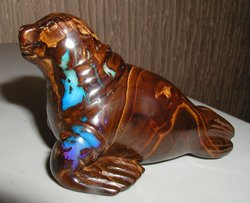Opal
|
|
| Opal | |
|---|---|
| General | |
| Category | Mineraloid |
| Chemical formula | Hydrated silica. SiO2·nH2O |
| Identification | |
| Colour | White, black, red, orange, most of the full spectrum, colorless, iridescent. Very infrequently of a singular colour |
| Crystal habit | Irregular veins, in masses, in nodules. |
| Crystal system | Amorphous |
| Cleavage | None |
| Fracture | Conchoidal to uneven |
| Mohs Scale hardness | 5.5 - 6.6 |
| Luster | Vitreous to resinous |
| Refractive index | 1.44 - 1.46 |
| Pleochroism | None |
| Streak | White |
| Specific gravity | 2.1 - 2.3 |
| Major varieties | |
| Black opal, white opal, water opal, fire opal, potch. | |
The mineraloid opal is amorphous SiO2·nH2O; hydrated silicon dioxide, the water content sometimes being as high as 20%. Opal ranges from colorless through white, milky blue, gray, red, yellow, green, brown and black. Often many of these colors can be seen at once, caused by interference and diffraction of light passing through minute, regularly arranged apertures within the microstructure of opal, known as Bragg's lattice. These apertures are filled with secondary silica and form thin lamellae inside the opal during solidification. The term opalescence is commonly and erroneously used to describe this unique and beautiful phenomenon, which is correctly termed play of color. Contrarily, opalescence is correctly applied to the milky, turbid appearance of common or potch opal. Potch does not show a play of color.
The veins of opal displaying the play of color are often quite thin, and this has given rise to unusual methods (http://www.opalsdownunder.com.au/articles/cutting.htm) of preparing the stone as a gem. An opal doublet is a thin layer of colorful material, backed by a black mineral, such as basalt or obsidian. The darker backing emphasizes the play of color, and results in a more attractive display than a lighter potch. Given the texture of opals, they can be quite difficult to polish to a reasonable lustre. The triplet cut backs the colored material with a dark backing, and then has a cap of clear quartz (rock crystal) on top, which takes a high polish, and acts as a protective layer for the comparatively delicate opal.
Besides the gemstone varieties that show a play of color, there are other kinds of common opal such as the milk opal, milky bluish to greenish; resin opal, honey-yellow with a resinous lustre; wood opal, caused by the replacement of the organic material in wood with opal; menilite brown or grey; hyalite, a colorless glass-clear opal sometimes called Muller's Glass; geyserite, (siliceous sinter) deposited around hot springs or geysers; and diatomite or diatomaceous earth, the accumulations of diatom shells or tests.
Opal is a mineraloid gel which is deposited at relatively low temperature and may occur in the fissures of almost any kind of rock, being most commonly found with limonite, sandstone, rhyolite, and basalt. The word opal comes from the Sanskrit upala, the Greek opallios, and the Latin opalus, meaning "precious stone."
Opal is one of the minerals that can form or replace fossils. The resulting fossils, though not of any extra scientific interest, appeal to collectors.
A large fraction of the world's opal comes from Australia. The town of Coober Pedy, in particular, is a major source. Common, water, jelly, and fire opal are found mostly in Mexico and Mesoamerica.
As well as occurring naturally, opals of all varieties have been synthesized experimentally and commercially. The resulting material is distinguishable from natural opal by its regularity; under magnification, the patches of colour are seen to be arranged in a "lizard skin" or "chicken wire" pattern. Synthetics are further distinguished from naturals by the former's lack of phosphorescence under UV light. Synthetics are also generally lower in density and are often highly porous; some may even stick to the tongue.
Two notable producers of synthetic opal are the companies Kyocera and Inamori of Japan. Most so-called synthetics, however, are more correctly termed imitations, as they contain substances not found in natural opal (e.g., plastic stabilizers). The Gilson opals often seen in vintage jewellery are actually an imitation consisting of laminated glass with bits of foil interspersed.
The opal is the official gemstone of South Australia. Opal is the official birthstone of the month of October.
See also
References and external links
- Hurlbut, Cornelius S.; Klein, Cornelis, 1985, Manual of Mineralogy, 20th ed., ISBN 0471805807
- Mineral Galleries - Opal (http://mineral.galleries.com/minerals/mineralo/opal/opal.htm)
- Mindat.org - Opal (http://www.mindat.org/min-3004.html)
- Minerals.net - Opal (http://www.minerals.net/mineral/silicate/tecto/quartz/opal.htm)
- Berkeley - Great photos (http://ist-socrates.berkeley.edu/~eps2/wisc/Lect16b.html)bg:Опал


